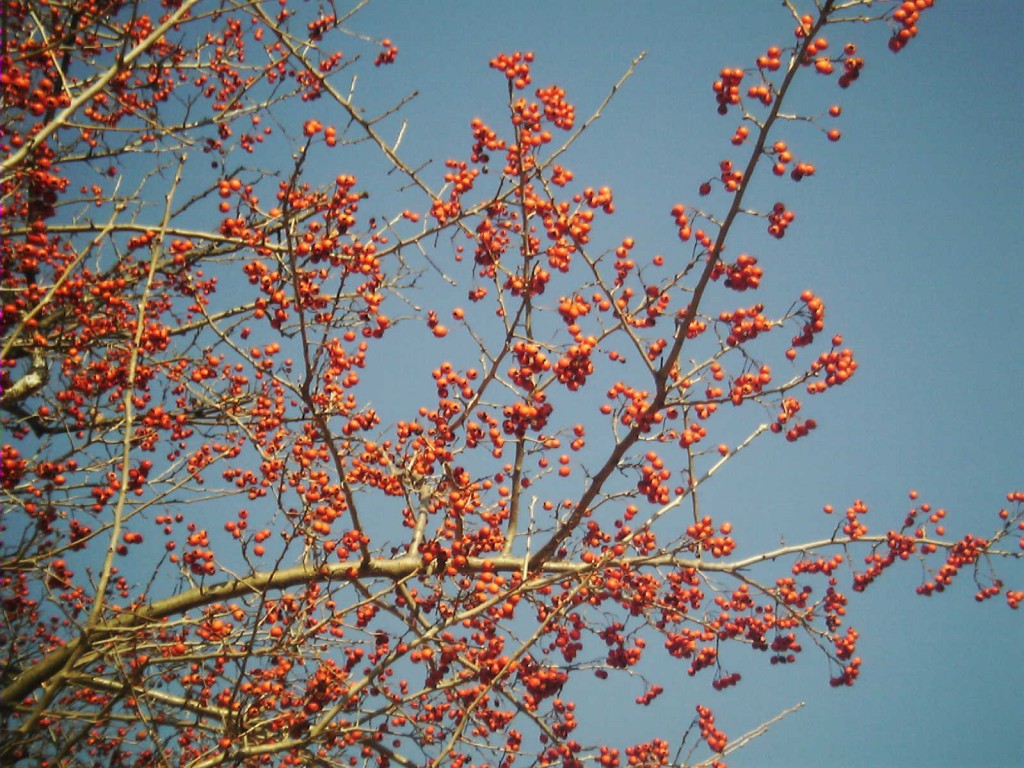The garden is feeling camera shy this week. It’s had a long dry summer and we are both really looking forward to some rain. I’m starting construction soon, finally replacing my chain link fence after years of masking the eyesore with plants. Since many of my plants took a beating this year anyway (due to many factors, spilt milk), it seemed like a good time to hit the pause button and get a proper backdrop in place. At this point I’m just coasting out the summer and looking forward to next season, in this case, spring, when the construction is done. In my fantasy garden “next season” is never two seasons away, waiting out the fall and winter in anticipation of spring, holding over with only the evergreens, so the garden isn’t completely asleep. It would be much more fun to approach winter with anticipation of a spectacular garden show. I have such envy every time I see winter trees and shrubs covered in fruit and berries, and realize the garden could still be unfolding all year round, festively decorated and inviting the birds to stop by.

Creative Commons License Attribution-Share Alike
Arbutus unedo is topping my wishlist. The fruit is a showstopper. It looks like something sugared for a Thanksgiving platter. It’s related to the Pacific madrone, but much smaller and easier to handle in a city garden. It’s usually around 15 feet, but can top out at 30′. If 30′ is more space than you have, there’s also Arbutus unedo ‘Compacta,’ which grows up to only about 10 feet, or Arbutus unedo ‘Elfin King’ which grows to 8′. It likes sun but can handle some light shade, and can make it through summer much water. Definitely need this.

Creative Commons License Attribution-Share Alike
Aren’t the fruits magical looking?

Creative Commons License Attribution-Share Alike
The unripe fruits of Arbutus unedo ‘Compacta’, also looking beautiful when young fruits show up green.
I’ve got a huge crush on Japanese persimmon. I wonder why you don’t see them more often. They’re such a standout in winter gardens. Every December I drive from Portland to Seattle for a family get together, and you can see these from the road, peeking through the mist. So beautiful. Definitely on my wishlist.

Creative Commons License Attribution-ShareAlike, CC BY-SA
I love the stark beauty of the fruit against bare wood, but it’s also beautiful when the fall leaves are paired with the fruit.

After growing up with gangly looking Hawthornes as the official street tree in my neighborhood I’d never thought I’d some day see the charms of a Hawthorne again, but in the wise words of Loree, never say never. Some have such beautiful red fruit, I have to take back all those mean things I said about them. This one is Crataegus pinnatifida, but I’m not sure it’s the ones I see around my my neighborhood, which have a nice symmetrical shape, glossy leaves, gorgeous fall color, and huge red fruit all winter. I haven’t yet figured out the ID, possibly it’s Crataegus pinnatifida major? Let me know in the comments if you might know the beauty I’m thinking of. I may owe this tree a bit more consideration.

Used with permission, all rights reserved
There are of course many hollies that offer their cheery red berries, but you don’t see golden orange as often. Ilex verticillata ‘Winter Gold’ is positively covered with these lovelies in winter. Can you imagine repeating the color of this with the persimmon?

Used with permission, all rights reserved
I think it’s illegal to talk about fall berries without mentioning the Callicarpa genus.The purple berries never escape attention. Callicarpa dicotoma ‘Early Amethyst’ kicks off the show in September.

Used with permission, all rights reserved
I have a soft spot for the white berried variety, Callicarpa japonica ‘Leucocarpa,’ which has bigger leaves that turn yellow in fall when the white berries begin to appear.

Photo by Tubifex, public domain
And while I’m daydreaming, I may as well throw in an honorable mention for pomegranates, one those plants that seem so exotic when you see them around here, dangling unexpectedly from shrubs. There are some in an unusually good roadside median planting here in Portland. If they fruit this year, I’ll have to go get a decent picture. The ones I shot from the car window last year don’t do them justice. Pomegranates are one of my favorite foods, I love to toss a handful of seeds in just about everything I eat while they’re available. And slowly, sadly, toward the end of the season, you buy the lovely fruits, open them up, and see that they’re starting to go to mush, and the end is near, until next year. But on the bright side, it means spring is drawing near, with a whole new flush of garden growth to get excited about. By now, I’ve almost forgotten how I started this post, thinking about the end of the season, waiting for months to pass. This is not how I want to think of my garden! As I plan to rebuild over the next year, this is my goal: there will always be something to look forward to next season. The end of one thing signals the beginning of another. There will always be a reason to walk through the garden, watch the birds, and enjoy the signs of the season.
Have I missed any of your favorites that you’re looking forward to this year?
